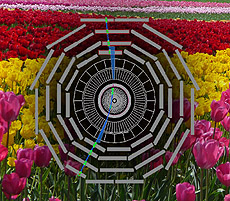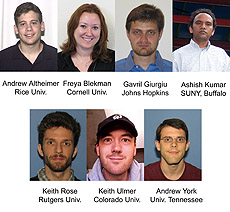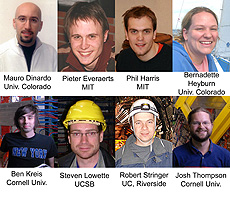A gentle cosmic rain
 |
Cosmic rays from space passing through the heart of the CMS detector help align the equipment to an accuracy that is nearly perfect. |
Editor's note: This is the second article in a two-part series that describes the CMS experiment's successful cosmic ray run. Read the first part here.
As I stare out my window at the cold and dreary rains of autumn, it reminds me of the sleet and snow soon to come. I have to remind myself that rain can be a good thing. For instance, the early spring rains are crucial for making the flowers bloom. Indeed, rain is vital for growth.
The CMS collaboration has exploited another type of rain, this one the constant flux of cosmic ray muons that bathes the Earth. Protons accelerated across the cosmos hit the Earth's atmosphere, initiating a shower of thousands of particles that eventually turn into muons. Muons have the very convenient property that they interact relatively weakly and travel essentially in a straight line as they pass through matter. A few of them will travel through the 300 feet of rock above the LHC and pass directly through the CMS detector.
A large detector such as CMS needs all of its equipment to function properly, but the heart of CMS has very special requirements. The CMS collaboration made the bold choice to build a central tracker entirely of silicon. Silicon detectors can measure the path of particles traveling through it with extraordinary precision. However, to exploit this ability, scientists need to know the exact location of each component. This is because each piece of silicon hit by a muon electronically reports the particle's passage. By knowing which silicon detectors are hit and their exact location, scientists can reconstruct the path of the particle.
The CMS detector consists of 75 million bits of silicon, contained in more than 16,000 modules. This is the largest silicon detector in the world, containing 100 times more channels than the previous generation. By using more than 3 million cosmic ray muons that passed through the CMS silicon detector, scientists know the positions of the modules to a precision better than 10 times smaller than a human hair. This has essentially achieved the detector's ideal performance and is a striking achievement.
— Don Lincoln
 |
| These junior physicists were responsible for aligning the CMS silicon systems to an accuracy that is literally as good as possible. |
 |
| This group of young scientists made substantial contributions in keeping the CMS silicon systems operating reliably. The first step in making a detector work is stable operations. |
|